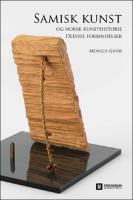Samisk kunst og norsk kunsthistorie
Delvise forbindelser
Abstract
Sápmi, the Sámi area, is transnational; it transcends four nation states, Norway, Sweden, Finland, and Russia. Art and art history has been considered natural parts of a nation state’s inventory at least since the 19th century and has contributed to the production and maintenance of national identities and narratives. What is the role of the nation state in art history, and how has the national paradigm affected the presentation of Sámi art, historically and today? Focusing on the discipline of art history in Norway, the volume exposes the prevailing representation of Sámi art, duodji, and dáidda as ethnographic material and relates it to the politics of nation building in the nineteenth and early twentieth century. The book examines the representation of Sámi art, artefacts, practices, materialites, actors, concepts, and themes in Norwegian Art History, to uncover some of the established disciplinary mechanisms and narratives. The central method is historiography in combination with fieldwork in archives and museums, aimed at doing art historiography in the expanded field – to move beyond the traditional textual focus and question naturalized institutional and disciplinary boundaries. This is one of very few historiographical studies of the art historical discipline in Norway, and the only one that does this by centring on Sámi traditions, items, actors, and conceptualizations.
Keywords
Norwegian art; Sámi art; Representation; Reception; Historiography; Art HistoryDOI
10.16993/bbmISBN
9789176351529, 9789176351536, 9789176351543, 9789176351550, 9789176351529Publisher
Stockholm University PressPublisher website
https://www.stockholmuniversitypress.se/Publication date and place
Stockholm, 2021Imprint
Stockholm University PressSeries
Stockholm Studies in Culture and Aesthetics, 9Classification
Philosophy: aesthetics
History of art
Prehistoric styles
Cultural studies
History of ideas
Indigenous peoples
Relating to Indigenous peoples
Museology and heritage studies


 Download
Download Web Shop
Web Shop